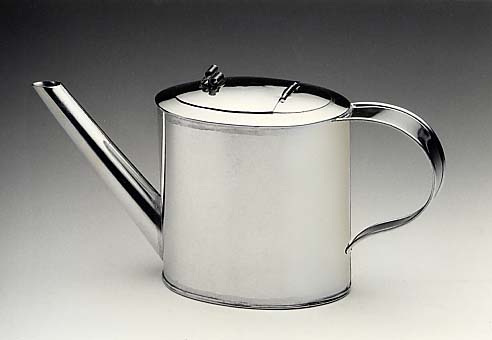Teapot, Candlestick, One-sheet Waiter
 |
Teapots such as this one of American design were common.
All are quite similar differing mainly in the style of the knob
on the hinged cover - knob variations ranged from one to three
rings. This design is no doubt patterned after English teapots,
one of which has an unhinged top that is capped with a white-metal
acorn finial and a handle with a thumb rest and brace. Many American
teapots were decorated. Water for tea would have been boiled
in another container - the teapot being used only for steeping
and serving. This teapot, soldered with lead-free solder, is
safe to use.
| K-111-PAR |
American Teapot 4 1/2"W x 3 1/4"D
x 4 1/2"H |
$325.00 |
American Teapot
 |
The candlestick is typical of many early ones often referred
to as hogscraper candlesticks. It was made to be used in one
place rather than carried about; there would have been less guttering
of the candle and so the narrow rim around the candle socket
was adequate to catch the dripping tallow. A hook was sometimes
incorporated in the rim of the drip cup so that the candlestick
could be hung on the back of a ladderback chair to provide light
over the shoulder for reading. The 'push-up' in the stem aided
in the removal of the candle stub.
| L-107-PAR |
Candlestick 4"Dia. x 5"H |
$200.00 |
-
Trays were commonly called 'waiters' - this particular
one a coffin-lid waiter or coffin tray - so named because its
shape closely resembled that of early coffins. In the 1700's
tinplate was made in sheets that measured ten by fourteen inches.
A one-sheet waiter was made from a single sheet of tinplate and
a two-sheet waiter was made from two sheets that were seamed
together. Quarter- and half-sheet waiters were also made.
| K-109A-PAR |
One-sheet Waiter 12 1/2"W x 8 1/2"D
x 3/4"H |
$165.00 |
|




